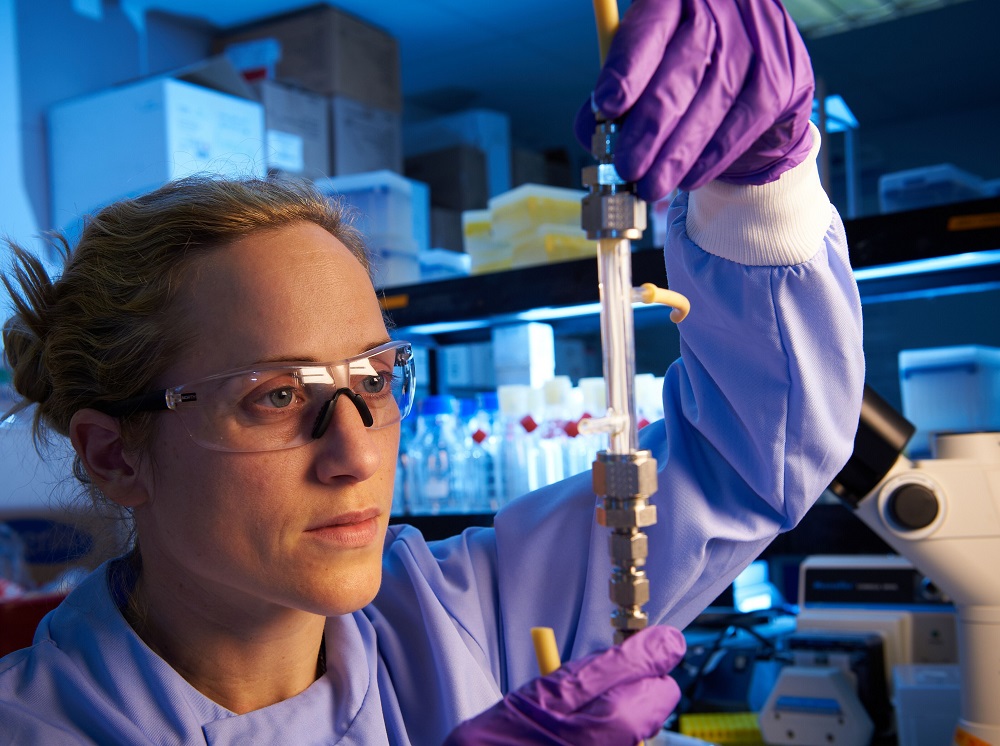When could cell-cultured food products appear on the Codex agenda?
In a search for alternative sources of meat and in response to concerns over meat consumption, animal welfare and greenhouse gas emissions, scientists have developed the ability to grow meat from animal cells in a laboratory. The process involves taking tissue from a live animal and extracting stem cells which are then grown into muscle fibres in a bioreactor.
Developing awareness of emerging issues such as this is a key component of strategic planning in Codex.

Marianne Ellis, Bath University, produces cultured meat in the laboratory
Marianne Ellis is a Biochemical Engineer at Bath University, UK and her team has taken cells grown and matured in a bioreactor and then combined them with other ingredients to make products such as burgers, sausages and meat balls. However, cultured meat technology is still at an early stage with key technical challenges ahead. “It is anticipated that cultured meat products will be available in some high-end food outlets in the next year or so, based on some US company predictions,” said Ellis, but in Europe the estimate is 4-5 years. Ellis also argues that cultured meat can bring benefits for food security, in terms of protein, and significant environmental sustainability benefits due to relatively lower greenhouse gas emissions, water use and land use, and less energy, compared to traditional meat production.
The science is still in its infancy.
The science “is still in its infancy and we have yet to discover if lab-grown ‘meat’ is a viable option on a large scale, said Hsin Huang, Secretary General of the International Meat Secretariat, a non-profit organization working in the global meat and livestock sector and a Codex Observer. In welcoming discussions on sustainable food systems, Huang also questioned the “expense, resource input and environmental impact of artificial ‘meat’”, especially regarding CO2 emissions.
Regulators need to look ahead
One of the objectives of FAO/WHO/AU Food Safety Conference in Addis this year was to alert decision-makers about the emerging opportunities and challenges affecting food systems with relevance to food safety. “On the topic of cell-cultured meat, several questions were raised at the Conference: which regulatory agencies would be responsible for the safety of such products? How would they be labelled?” said Renata Clarke Head of the FAO Food Safety and Quality Unit.
The standard-setting environment has a part to play.
”Every committee in Codex has a responsibility to look ahead and examine issues that may require internationally harmonized standards in the future”, said Tom Heilandt, Secretary of the Codex Alimentarius Commission. When new technologies become available consumers can often be skeptical and uncertain about the risks and benefits involved. “The standard-setting environment has a part to play regarding the quality and safety of new products and as lab-grown meat becomes more important, Codex will be a necessary part of that discussion. And beyond quality and safety, Codex labeling requirements will make sure that consumers have all the information they need”, he said.
Read more
Novel food production - Aideen I. McKevitt, Institute of Food and Health, University College Dublin, Ireland
Stephens, N., Di Silvio, L., Dunsford, I., Ellis, M., Glencross, A., & Sexton, A. (2018). Bringing cultured meat to market: Technical, socio-political, and regulatory challenges in cellular agriculture. Trends in food science & technology, 78, 155–166. doi:10.1016/j.tifs.2018.04.010
الاقسام
- (11)
- (3)
- Animal Feed (8)
- Antimicrobial Resistance (39)
- Antimicrobial Resistance (78)
- CAC46 (15)
- Codex Texts (20)
- Codex Trust Fund (1)
- Codex60 (19)
- Contaminants (13)
- Contaminants (10)
- COVID-19 (64)
- Elections (6)
- Food Safety (126)
- Labelling (10)
- Nutrition and Labelling (5)
- Nutrition and Labelling (7)
- Observers (23)
- Pesticides (7)
- Standards (78)
- World Food Safety Day (154)


